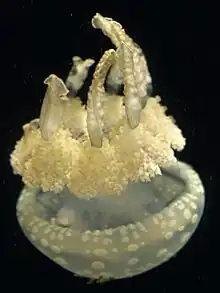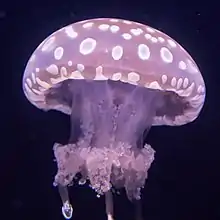Mastigias
Mastigias is a genus of true jellyfish in the family Mastigiidae. It contains seven described species. Members of this genus are found widely in coastal regions of the Indo-Pacific, including saline lakes of Palau (e.g., Jellyfish Lake), but there are also records from the West Atlantic at Florida and Puerto Rico. The West Atlantic records are most likely the result of accidental introductions by humans.[1]
| Mastigias | |
|---|---|
 | |
| Mastigias papua | |
| Scientific classification | |
| Domain: | Eukaryota |
| Kingdom: | Animalia |
| Phylum: | Cnidaria |
| Class: | Scyphozoa |
| Order: | Rhizostomeae |
| Family: | Mastigiidae |
| Genus: | Mastigias Agassiz, 1862 |
| Species | |
|
7 species, see text | |
Species
According to the World Register of Marine Species, this genus includes seven species:[2]
- Mastigias albipunctatus
- Mastigias andersoni
- Mastigias gracilis
- Mastigias ocellatus – golden medusa
- Mastigias pantherinus
- Mastigias papua – spotted jelly
- Mastigias siderea
Synapomorphies
For reproduction, Mastigias pupua has adopted a mono-mode reproductive strategy that develops only free-swimming buds.[3] Mastigias organisms also are able to produce swimming frustules, a hard and porous cell wall covering diatoms.[4]

Habitat
The genus Mastigias is native to the western and central Indo-Pacific, from Australia to Japan, and Micronesia to the Indian Ocean.[5] However, most Mastigias organisms choose to live in landlocked marine lakes.[6] Behavioral differences among this genus do occur with varying habitats. Marine lake Mastigias' swim slower than their oceanic ancestors.[7] The Mastigias genus may have to adapt to a habitat with warmer temperatures. With growing temperature deviation above the average, organisms within this genus have seen a decrease in population[8] as well as growing mortality rates.[9]
Interactions
Mastigias jellyfish have a symbiotic relationship with zooxanthellae[10] living in host gastrodermal cells where they exhibit phased division.[11] The Mastigias genus of jellyfish symbiotically produce ephyrae only in the presence of Symbiodinium, in a process called strobilation.[12]
References
- Bayha, Keith M.; Graham, William M. (2011). "First confirmed reports of the rhizostome jellyfish Mastigias (Cnidaria: Rhizostomeae) in the Atlantic basin" (PDF). Aquatic Invasions. 6 (3): 361–6. doi:10.3391/ai.2011.6.3.13.
- "Mastigias". WoRMS. World Register of Marine Species. Retrieved 3 August 2012.
- Galeano, Gloria; Bernal, Rodrigo (2013-11-08). "Sabinaria , a new genus of palms (Cryosophileae, Coryphoideae, Arecaceae) from the Colombia-Panama border". Phytotaxa. 144 (2): 27–44. doi:10.11646/phytotaxa.144.2.1. ISSN 1179-3163.
- Raskoff, Kevin (2003). "Collection and Culture Techniques for Gelatinous Zooplankton". Biological Bulletin. 204 (1): 68–80. doi:10.2307/1543497. JSTOR 1543497. PMID 12588746. S2CID 22389317 – via JSTOR.
- Kramp, P. L. (November 1961). "Synopsis of the Medusae of the World". Journal of the Marine Biological Association of the United Kingdom. 40: 7. doi:10.1017/S0025315400007347. ISSN 0025-3154.
- "Front Matter". Proceedings of the National Academy of Sciences of the United States of America. 102 (26): 9088. 2005. JSTOR 3375851 – via JSTOR.
- Dawson, Michael (2016). "Island and island-like marine environments". Global Ecology and Biogeography. 25 (7/8): 831–846. doi:10.1111/geb.12314. JSTOR 43871671 – via JSTOR.
- Purcell, Jennifer (2007). "Environmental effects on asexual reproduction rates of the scyphozoan Aurelia labiata". Marine Ecology Progress Series. 348: 183–196. doi:10.3354/meps07056. JSTOR 24872030 – via JSTOR.
- Dawson, Michael (2005). "Coupled Biophysical Global Ocean Model and Molecular Genetic Analyses Identify Multiple Introductions of Cryptogenic Species". Proceedings of the National Academy of Sciences of the United States of America. 102 (34): 11968–11973. doi:10.1073/pnas.0503811102. JSTOR 3376382. PMC 1189321. PMID 16103373 – via JSTOR.
- Jantzen, Carin (2010). "Enhanced pore-water nutrient fluxes by the upside-down jellyfish Cassiopea sp. in a Red Sea coral reef". Marine Ecology Progress Series. 411: 117–125. doi:10.3354/meps08623. JSTOR 24874028.
- Fitt, W.K. (2000). "Cellular Growth of Host and Symbiont in a Cnidarian-Zooxanthellar Symbiosis". Biological Bulletin. 198 (1): 110–120. doi:10.2307/1542809. JSTOR 1542809. PMID 10707819 – via JSTOR.
- Farmer, Mark (2001). "Morphology of the Symbiosis between Corculum cardissa (Mollusca: Bivalvia) and Symbiodinium corculorum (Dinophyceae)". Biological Bulletin. 200 (3): 336–343. doi:10.2307/1543514. JSTOR 1543514. PMID 11441975. S2CID 36707009 – via JSTOR.